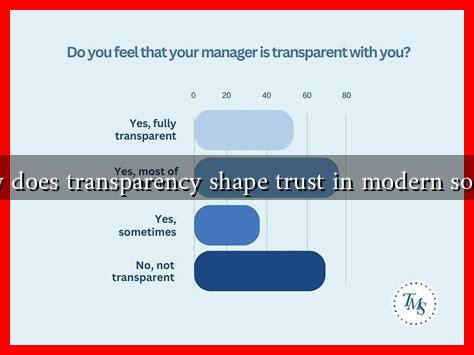-
Table of Contents
How Does Transparency Shape Trust in Modern Society?
In an age characterized by rapid information exchange and digital connectivity, transparency has emerged as a cornerstone of trust in various sectors, including government, business, and personal relationships. The concept of transparency refers to the openness and clarity with which organizations and individuals communicate their actions, decisions, and policies. This article explores how transparency shapes trust in modern society, supported by relevant examples, case studies, and statistics.
The Importance of Transparency
Transparency is vital for fostering trust, as it allows stakeholders to understand the motivations and actions of others. In a world where misinformation can spread rapidly, being transparent helps to mitigate doubts and suspicions. Here are some key reasons why transparency is essential:
- Accountability: Transparency holds individuals and organizations accountable for their actions, ensuring that they adhere to ethical standards.
- Informed Decision-Making: When information is readily available, stakeholders can make informed choices based on facts rather than assumptions.
- Enhanced Reputation: Organizations that practice transparency often enjoy a better reputation, leading to increased customer loyalty and trust.
- Reduced Corruption: Transparency can deter corrupt practices by exposing wrongdoing and promoting ethical behavior.
Transparency in Government
In the realm of government, transparency is crucial for democratic governance. Citizens expect their leaders to be open about policies, spending, and decision-making processes. A notable example is the Freedom of Information Act (FOIA) in the United States, which allows citizens to request access to government records. According to a report by the Brookings Institution, increased transparency in government operations has led to greater public trust and engagement.
Moreover, countries like New Zealand and Sweden are often cited as models of transparency in governance. These nations have implemented robust systems for public access to information, resulting in higher levels of citizen trust and participation in the democratic process.
Transparency in Business
In the business sector, transparency is increasingly recognized as a competitive advantage. Companies that are open about their practices, supply chains, and financial performance tend to build stronger relationships with customers and investors. A study by Accenture found that 62% of consumers want companies to take a stand on social, cultural, and political issues, indicating that transparency about values and ethics is crucial for building trust.
One prominent example is Patagonia, an outdoor clothing brand known for its commitment to environmental sustainability. The company openly shares information about its supply chain and environmental impact, which has garnered a loyal customer base that trusts its brand values.
The Role of Technology in Enhancing Transparency
Technology plays a significant role in promoting transparency. The rise of social media and digital platforms has made it easier for individuals and organizations to share information quickly and widely. However, this also comes with challenges, as misinformation can spread just as rapidly. Here are some ways technology enhances transparency:
- Real-Time Communication: Social media allows organizations to communicate directly with stakeholders, providing updates and addressing concerns in real time.
- Data Transparency: Blockchain technology offers a secure way to share information about transactions, ensuring that all parties have access to the same data.
- Online Reviews and Ratings: Platforms like Yelp and TripAdvisor enable consumers to share their experiences, holding businesses accountable for their practices.
Challenges to Transparency
Despite its benefits, achieving transparency is not without challenges. Organizations may hesitate to disclose certain information due to concerns about competitive advantage or legal implications. Additionally, the sheer volume of information available can lead to information overload, making it difficult for stakeholders to discern what is relevant.
Moreover, the digital age has given rise to issues of privacy and data security, complicating the balance between transparency and confidentiality. Organizations must navigate these challenges carefully to maintain trust while protecting sensitive information.
Conclusion
In conclusion, transparency is a fundamental element that shapes trust in modern society. Whether in government, business, or personal relationships, being open and clear about actions and decisions fosters accountability, informed decision-making, and enhanced reputations. As technology continues to evolve, it offers new avenues for promoting transparency, although challenges remain. Ultimately, organizations and individuals that prioritize transparency are likely to build stronger, more trusting relationships with their stakeholders, paving the way for a more engaged and informed society.



